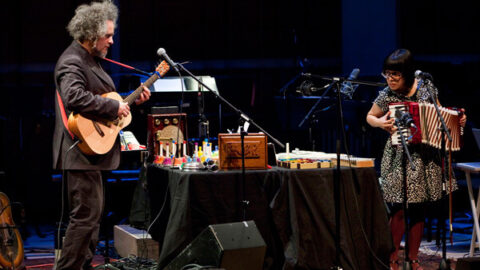 The length of an usual article on this blog would probably not be enough to merely list the different instruments crowded on to the stage at the concert that Sxip (pronounced “Skip”) Shirey and Angélica Negrón presented as part of the Ecstatic Music Festival 2012 on Tuesday, February 7 at Merkin Hall. The two headliners of this show are both multi-instrumentalist composers and performers of a decidedly experimental, quirky bent. They had apparently never collaborated before, but were brought together by Ecstatic curator Judd Greenstein, who rightly speculated that their mutual love of all sorts of bells, glockenspiels, and other unusual percussive and sustained sound choices (electronically altered harmonica, accordion, prepared guitar, melodica, glass bowls with marbles, and so on) would lead to unique synergies in their joint efforts.
The length of an usual article on this blog would probably not be enough to merely list the different instruments crowded on to the stage at the concert that Sxip (pronounced “Skip”) Shirey and Angélica Negrón presented as part of the Ecstatic Music Festival 2012 on Tuesday, February 7 at Merkin Hall. The two headliners of this show are both multi-instrumentalist composers and performers of a decidedly experimental, quirky bent. They had apparently never collaborated before, but were brought together by Ecstatic curator Judd Greenstein, who rightly speculated that their mutual love of all sorts of bells, glockenspiels, and other unusual percussive and sustained sound choices (electronically altered harmonica, accordion, prepared guitar, melodica, glass bowls with marbles, and so on) would lead to unique synergies in their joint efforts.

Shirey and Negrón’s choice of collaborating partners for the show only added to the profusion of sounds. Jonny Rodgers is a tuned wine glass virtuoso (yes, you read that correctly), who added his perfectly timed, delicate harmonies to several works, and also presented his own piece, a gentle protest song with lyrics in both Latin and English, Spero/Sparrow. Founding ETHEL violinist Todd Reynolds played his virtuosic rock and electronic beat-driven solo work Transamerica (featured on our Fall 2011 mixtape, Ed.), as well as joining Shirey and Rodgers later on. Noveller, aka Sarah Lipstate, is an electric guitar/effects wizard, who often uses a bow to set up her basic looping riffs, on top of which she adds a variety of plucked and strummed patterns.


Many of this concert’s works had no real sense of structure or formalism, but simply meandered through various bizarre, ethereal soundscapes, then stopped when they felt like it. In some cases, this approach worked well, as in Shirey’s piece Trains. He uses a heavily prepared acoustic guitar to mimic the sound of long trains going around bends. The sound of the guitar was further distorted and transformed when Shirey began striking the strings with a harmonica. Trains is full of harsh and otherworldly sounds, but it isn’t very long (around two minutes), and the effects are so impressive and striking that it doesn’t get old although it could be hard to listen to music of this same type but of longer duration.
However, several of the pieces, especially the Negrón/Noveller collaboration At Dusk, suffered from a lack of forward momentum: although expertly played, and despite the unusual spectacle of hearing both a violin and an electric guitar being bowed simultaneously, this work felt like a gauzy veil that wasn’t concealing anything substantive. Although minimalist pieces of this type often don’t adhere to any more traditional structures, more effective entrants in the genre have subtle shifts and occasional moments of dissonance, which provide much-needed contrast. At Dusk would be effective as soundtrack music, but did not hold up as a concert work.

The only group of performers included in the evening was Face the Music, a chamber ensemble consisting of middle- and high-school students from around the NYC area. Although they are indeed very serious performers who play well together, especially considering their youth, they were pushed to and even slightly beyond their limits by Negrón’s composition El Gran Caleidoscopio. Not only were the tightly interlocking rhythms hard for the group to handle, many of them were asked to switch instruments (several of them wielded rainsticks in addition to their orchestral instruments), sing; several of the young musicians had to move about the stage at different times. It was a highly sectional piece, although presented as a single movement, with sudden shifts in mood and in orchestral emphasis throughout, while each individual section felt relatively static, more about atmosphere, mood, and timbre than melody or specific harmonic goals. Negrón’s skills as a composer who creates haunting abstractions with complex layers were displayed to great effect in El Gran Caleidoscopio (even if the musicians struggled a bit)—in fact, the juxtaposition of the familiar orchestral instruments with the more unusual choices was more pleasing than some of the other works, which relied entirely on things like collections of hand-bells, vocal screeches, and dissonant accordion chords.

Shirey, Negrón, et al. are comfortable in their musical skin. Shirey, in particular, is a true showman, who added funny and elucidating anecdotes before many of his pieces—these were not only entertaining, but made the pieces’ goals more clear (especially Trains). Naturally, any concert that is as cutting-edge as this one is bound to have both technical hiccups and compositions that don’t quite hang together. However, in an era when all the “rules” of music have been broken so many times and in so many ways that they are almost meaningless, it is refreshing to hear something genuinely unusual. Indeed, it is a testament to the success—philosophical success among artists, if not commercial success among audiences—of the great groundbreakers of the 20th century (Cage, Crumb, Berio, and so on) that performers like Negrón and Shirey don’t come off as rebels, they are simply musical omnivores doing what comes naturally to them, and doing it with verve, wit, and even moments of ecstatic joy.
Listen to the entire concert on Q2 at http://www.wqxr.org/#/articles/q2-live-concerts/2012/feb/09/sxip-shirely-angelica-negron-live-merkin-concert-hall
—
Matt Weber is a New York based composer, educator, and political slacktivist.
























